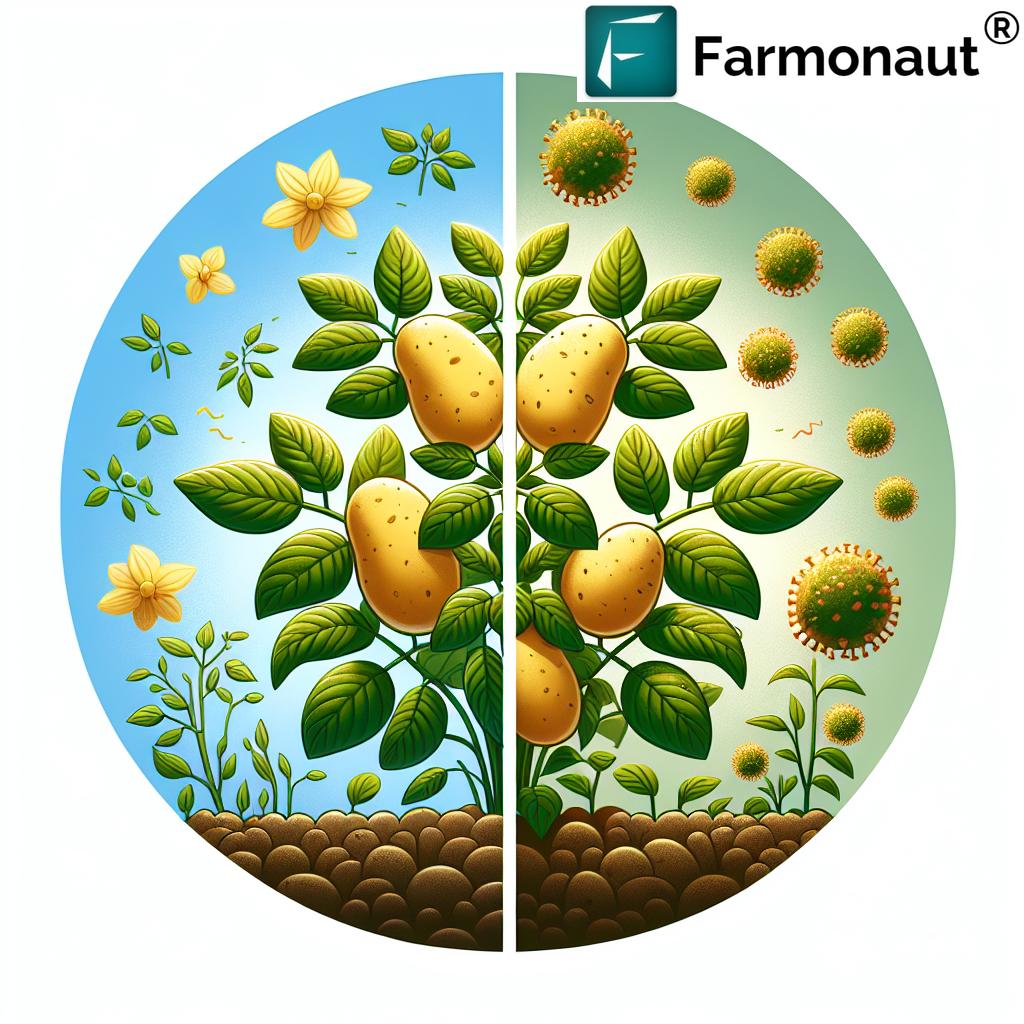Organic Whitefly Control: Protecting Your Crops from Pests and Viruses

At Farmonaut, we understand the challenges farmers face when it comes to protecting their crops from pests and diseases. One of the most persistent and damaging pests in agriculture is the whitefly. These tiny, winged insects can wreak havoc on a wide variety of crops, causing significant economic losses and spreading harmful plant viruses. In this comprehensive guide, we’ll explore the world of whiteflies, their impact on agriculture, and most importantly, how to control them using organic methods.
Understanding Whiteflies: A Farmer’s Nemesis
Whiteflies are small, sap-sucking insects that belong to the order Hemiptera. Despite their name, they are not true flies but are more closely related to aphids and scale insects. These tiny pests, measuring only about 1-2 mm in length, can cause extensive damage to crops and ornamental plants alike.
Characteristics of Whiteflies
- Appearance: Adult whiteflies have white, waxy wings and yellow bodies.
- Life Cycle: They undergo incomplete metamorphosis, with eggs, nymphs, and adults stages.
- Reproduction: Females can lay up to 400 eggs in their lifetime.
- Host Range: Whiteflies can infest over 500 plant species.
The Impact of Whiteflies on Crops
Whiteflies can cause significant damage to plants in several ways:
- Direct Feeding Damage: By sucking sap from plants, whiteflies weaken them, leading to yellowing leaves, stunted growth, and reduced yields.
- Honeydew Production: As they feed, whiteflies excrete a sticky substance called honeydew, which can promote the growth of sooty mold on leaves, further reducing photosynthesis.
- Virus Transmission: Perhaps most concerning is their ability to transmit plant viruses, particularly begomoviruses, which can devastate entire crops.
Whiteflies and Virus Transmission: A Double Threat
One of the most significant threats posed by whiteflies is their ability to transmit plant viruses, particularly begomoviruses. These viruses can cause severe damage to crops, leading to significant yield losses and economic hardship for farmers.
Understanding Begomoviruses
Begomoviruses are a group of plant viruses that are exclusively transmitted by whiteflies. They are known to infect a wide range of economically important crops, including:
- Cotton
- Tomatoes
- Peppers
- Beans
- Cassava
These viruses can cause a variety of symptoms in infected plants, including:
- Leaf curling and yellowing
- Stunted growth
- Reduced fruit size and quality
- Complete crop failure in severe cases
The Whitefly-Virus Relationship
The relationship between whiteflies and begomoviruses is complex and mutually beneficial:
- Whiteflies acquire the virus by feeding on infected plants.
- The virus replicates within the whitefly’s body.
- As the whitefly feeds on healthy plants, it transmits the virus.
- Infected plants often become more attractive to whiteflies, perpetuating the cycle.
This intricate relationship makes controlling both the whitefly population and the spread of viruses a critical challenge for farmers.
Whitefly Control: Traditional vs. Modern Approaches
Historically, farmers have relied on various methods to detect and control whitefly infestations. However, with the advent of advanced technologies like satellite imagery, we at Farmonaut are revolutionizing pest management strategies. Let’s compare traditional whitefly detection methods with our cutting-edge satellite system:
| Aspect | Traditional Whitefly Detection | Farmonaut Satellite System |
|---|---|---|
| Detection Speed | Slow, requires manual field scouting | Rapid, can cover large areas in minutes |
| Accuracy | Variable, depends on scout’s experience | High, uses advanced spectral analysis |
| Coverage Area | Limited to areas physically scouted | Can cover entire farms or regions |
| Cost-effectiveness | Labor-intensive and time-consuming | Highly cost-effective for large areas |
| Early Detection | Often detects infestations after visible damage | Can detect stress before visible symptoms appear |
As you can see, our satellite-based system offers significant advantages in terms of speed, accuracy, and coverage. By detecting whitefly infestations earlier and over larger areas, farmers can take proactive measures to protect their crops.
Organic Whitefly Control Strategies
At Farmonaut, we advocate for sustainable and environmentally friendly farming practices. When it comes to whitefly control, organic methods can be highly effective while minimizing the use of harmful chemicals. Here are some organic strategies we recommend:
1. Cultural Control Methods
- Crop Rotation: Regularly rotating crops can disrupt the whitefly life cycle and reduce population buildup.
- Companion Planting: Planting repellent crops like marigolds or basil near susceptible plants can deter whiteflies.
- Proper Plant Spacing: Adequate spacing between plants improves air circulation, making the environment less favorable for whiteflies.
- Weed Management: Removing weeds that may serve as alternate hosts for whiteflies and viruses.
2. Physical Control Methods
- Reflective Mulches: Using reflective materials like silver plastic mulch can confuse and repel whiteflies.
- Sticky Traps: Yellow sticky traps can capture adult whiteflies, helping to monitor and reduce populations.
- Row Covers: Physical barriers like fine mesh covers can prevent whiteflies from accessing plants.
3. Biological Control
Encouraging natural predators of whiteflies can be an effective organic control method. Some beneficial insects that prey on whiteflies include:
- Ladybugs
- Lacewings
- Predatory mites
- Parasitic wasps (e.g., Encarsia formosa)
These beneficial insects can be introduced to your garden or farm to help keep whitefly populations in check naturally.
4. Organic Sprays and Treatments
Several organic products can be effective against whiteflies:
- Neem Oil: This natural insecticide disrupts the whitefly life cycle and acts as a repellent.
- Insecticidal Soaps: These products break down the protective coating of whiteflies, causing dehydration.
- Horticultural Oils: Light oils can smother whitefly eggs and nymphs.
- Pyrethrin: Derived from chrysanthemum flowers, pyrethrin is an effective organic insecticide.
When using any organic products, it’s essential to follow the manufacturer’s instructions and apply them at the right time for maximum effectiveness.
Implementing an Integrated Pest Management (IPM) Approach
At Farmonaut, we believe in a holistic approach to pest management. Integrated Pest Management (IPM) combines various control methods to manage pest populations effectively while minimizing environmental impact. Here’s how you can implement an IPM strategy for whitefly control:
1. Regular Monitoring
Use our satellite-based monitoring system to detect early signs of whitefly infestations. Regular monitoring allows you to:
- Identify problem areas quickly
- Track the effectiveness of control measures
- Make informed decisions about when and where to intervene
2. Setting Action Thresholds
Establish economic thresholds for whitefly populations. This helps determine when control measures are necessary, avoiding unnecessary treatments and preserving beneficial insects.
3. Prevention
Implement preventive measures such as:
- Using disease-resistant plant varieties
- Maintaining plant health through proper nutrition and irrigation
- Practicing good sanitation to remove potential sources of infestation
4. Control
When action thresholds are reached, employ a combination of control methods, starting with the least harmful:
- Cultural and physical controls
- Biological controls
- Organic pesticides
- Synthetic pesticides (as a last resort)
5. Evaluation
Continuously assess the effectiveness of your control strategies and adjust as needed. Our satellite monitoring system can help you track the impact of your interventions over time.
Case Study: Organic Whitefly Control in Cotton
Cotton is one of the crops most susceptible to whitefly damage and the transmission of begomoviruses. Let’s explore how organic whitefly control methods can be applied effectively in cotton cultivation:
The Challenge
A cotton farmer in Gujarat, India, was facing significant yield losses due to whitefly infestations and the spread of Cotton Leaf Curl Virus (CLCuV), a begomovirus. The farmer wanted to transition to organic methods to control the pest and protect the crop.
The Solution
Working with Farmonaut’s satellite monitoring system and implementing an IPM approach, the farmer took the following steps:
- Early Detection: Using our satellite imagery, the farmer identified areas of stress in the cotton field before visible symptoms appeared.
- Cultural Controls: Implemented trap crops like okra around the cotton field to attract whiteflies away from the main crop.
- Physical Controls: Installed yellow sticky traps at regular intervals to monitor and reduce adult whitefly populations.
- Biological Control: Released ladybugs and lacewings as natural predators of whiteflies.
- Organic Sprays: Applied neem oil and insecticidal soaps on a rotating basis to disrupt the whitefly life cycle.
The Results
By implementing these organic control methods and using Farmonaut’s monitoring system, the farmer achieved:
- A 60% reduction in whitefly populations compared to the previous season
- 30% decrease in the incidence of Cotton Leaf Curl Virus
- 15% increase in cotton yield
- Improved soil health and beneficial insect populations
This case study demonstrates the effectiveness of combining organic control methods with advanced monitoring technologies to manage whitefly infestations in a sustainable manner.
The Role of Technology in Organic Whitefly Control
At Farmonaut, we’re at the forefront of integrating technology into organic pest management strategies. Our satellite-based monitoring system plays a crucial role in effective whitefly control:
1. Early Detection
Our satellite imagery can detect plant stress caused by whitefly infestations before visible symptoms appear. This early warning system allows farmers to take proactive measures, preventing widespread damage.
2. Precision Application
By identifying specific areas of infestation, our technology enables targeted application of organic control methods. This precision approach reduces unnecessary treatments, saving time and resources while minimizing environmental impact.
3. Monitoring Effectiveness
Our system allows farmers to track the effectiveness of their control measures over time. By comparing satellite images before and after treatment, you can assess the impact of your interventions and adjust your strategy accordingly.
4. Data-Driven Decision Making
The wealth of data provided by our satellite monitoring system empowers farmers to make informed decisions about pest management. By analyzing trends and patterns, you can develop more effective, long-term strategies for whitefly control.
Challenges in Organic Whitefly Control
While organic methods offer many benefits, they also come with certain challenges:
1. Slower Action
Organic treatments often work more slowly than synthetic pesticides. This requires patience and consistent application over time.
2. Weather Dependence
Many organic products are affected by weather conditions. Rain can wash away treatments, and some products break down quickly in sunlight.
3. Resistance Management
Even organic pesticides can lead to resistance if overused. It’s crucial to rotate control methods and products to prevent this.
4. Labor Intensity
Some organic control methods, like hand-removing infested leaves or applying treatments frequently, can be labor-intensive.
5. Cost Considerations
Initially, organic control methods may be more expensive than conventional pesticides. However, the long-term benefits often outweigh the upfront costs.
The Future of Organic Whitefly Control
As we look to the future, several exciting developments are on the horizon for organic whitefly control:
1. Advanced Biopesticides
Researchers are developing new, more effective biopesticides that target whiteflies specifically while being safe for beneficial insects.
2. Genetic Resistance
Plant breeders are working on developing crop varieties with enhanced natural resistance to whiteflies and the viruses they transmit.
3. Improved Monitoring Technologies
At Farmonaut, we’re continuously refining our satellite monitoring capabilities to provide even more accurate and timely pest detection.
4. Artificial Intelligence in Pest Management
AI-powered systems are being developed to predict pest outbreaks based on environmental conditions, allowing for proactive control measures.
5. Sustainable Ecosystem Management
There’s a growing focus on managing entire agricultural ecosystems to naturally suppress pest populations, rather than targeting pests in isolation.
Conclusion: Embracing Organic Whitefly Control for Sustainable Agriculture
As we’ve explored in this comprehensive guide, organic whitefly control is not just possible but increasingly essential for sustainable agriculture. By combining time-tested organic methods with cutting-edge technologies like Farmonaut’s satellite monitoring system, farmers can effectively manage whitefly populations while protecting their crops from devastating viruses.
The benefits of organic control extend beyond just pest management. By reducing reliance on synthetic pesticides, we can:
- Protect beneficial insects and pollinators
- Improve soil health
- Reduce environmental pollution
- Produce safer, healthier crops for consumers
At Farmonaut, we’re committed to supporting farmers in their transition to more sustainable pest management practices. Our advanced satellite monitoring system, combined with our expertise in precision agriculture, provides the tools and insights needed to implement effective organic whitefly control strategies.
As we face the challenges of feeding a growing global population while preserving our planet’s resources, organic pest control methods will play an increasingly crucial role. By embracing these sustainable practices and leveraging technologies like those offered by Farmonaut, we can create a more resilient, productive, and environmentally friendly agricultural system for future generations.
FAQs about Organic Whitefly Control
1. What are the most common signs of a whitefly infestation?
Common signs include:
- Tiny white flies that flutter when plants are disturbed
- Sticky honeydew on leaves
- Yellowing or wilting leaves
- Presence of sooty mold on leaves
2. Can whiteflies be completely eradicated using organic methods?
While complete eradication is challenging, organic methods can effectively manage whitefly populations to prevent significant crop damage. The goal is to keep populations below economically damaging levels.
3. How often should I apply organic treatments for whitefly control?
The frequency of application depends on the specific product and the severity of the infestation. Generally, treatments should be applied every 7-14 days or as directed on the product label. Continuous monitoring is crucial to determine the need for reapplication.
4. Are there any plants that naturally repel whiteflies?
Yes, several plants can help repel whiteflies:
- Marigolds
- Nasturtiums
- Basil
- Mint
- Chives
5. How does Farmonaut’s satellite system detect whitefly infestations?
Our satellite system uses multispectral imagery to detect changes in plant health and stress levels. Whitefly infestations cause specific spectral signatures that our advanced algorithms can identify, allowing for early detection before visible symptoms appear.
6. Can organic whitefly control methods be used in large-scale commercial farming?
Yes, organic methods can be scaled up for commercial farming. Many large-scale organic farms successfully use a combination of cultural, biological, and organic product-based control methods. Our satellite monitoring system is particularly useful for managing pest control in large areas.
7. How long does it take to see results from organic whitefly control methods?
Results can vary depending on the methods used and the severity of the infestation. Generally, you may start seeing a reduction in whitefly populations within 1-2 weeks of consistent application. However, it may take several weeks to achieve significant control.
8. Are organic whitefly control methods safe for beneficial insects?
Many organic control methods are designed to be safer for beneficial insects compared to synthetic pesticides. However, some organic products can still affect non-target insects if not used properly. It’s important to follow application instructions carefully and time treatments to minimize impact on beneficials.
9. How can I prevent whitefly infestations in the future?
Prevention strategies include:
- Regular monitoring using Farmonaut’s satellite system
- Maintaining plant health through proper nutrition and irrigation
- Using reflective mulches
- Implementing crop rotation
- Encouraging natural predators
10. Can whiteflies develop resistance to organic control methods?
While resistance is less common with organic methods compared to synthetic pesticides, it can still occur if the same control method is used repeatedly. That’s why we recommend an integrated pest management approach that combines multiple control strategies.

Ready to take your whitefly control strategy to the next level? Explore Farmonaut’s advanced satellite monitoring system and start protecting your crops more effectively today. Visit our app page to get started, or check out our API documentation for custom integrations. Download our mobile app for on-the-go monitoring: Android | iOS
For developers interested in integrating our satellite data into their own applications, visit our developer documentation.
Subscribe to Farmonaut’s services and take your farming to the next level:













